
Rhone-Alps
Grenoble, "the capital of the Alps"
Grenoble is amazing because of its location, nicely surrounded by the Alps, the Chartreuse mountains and Vercors, at the confluence of the Drac and Isere.
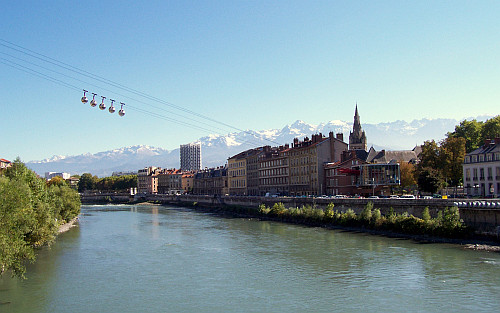
The "capital of the French Alps" and the capital of Dauphiné deserves a stophover for the stunning views we can enjoy once at the top of Bastille fort. Former Gallic city and then Gallo-Roman city, Grenoble is also the first revolutionary city on 7 June 1788 with "the day of the tiles", and the birthplace of the writer Stendhal. Grenoble hosted the Winter Olympic Games in 1968.
Bastille fort
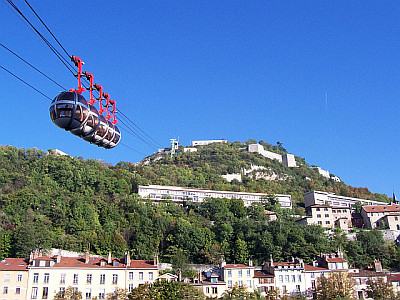
Bastille fort was built on the site of a 16th century fortress during the first half of the 19th century. It is located in a strategic location on a limestone rock at the heart of the city and overlooks the river Isère. It was used to defend the former border with Savoy then Italian.
We can access the fort either by footpath (quite hard...) or by cable car (fee payable) called the bubbles. Dating from 1934, this is the first cable car in the urban areas of France. It goes from 212 m (695 feet) to 475 m (1558 feet) in two minutes. The first cabins were rectangular. Two cables are required for its functioning. The upper cable is the cable on which run the pulleys. The lower cable is the cable that moves the cabin thanks to a motorized device with a system of counterweights.
At the top, we can follow trails to go in "high-altitude" walks of varying lengths. Near the fort, one can also notice Mandrin's caves. They are named after the famous smuggler, but in fact Mandrin was already dead for one century during their creation. They were hollowed out to shelter cannons.
Going down (or up for the braves !), the botanical trail provides access to a garden on one side, and on the other side to Sainte-Marie-d'en-Haut's (Santa Maria's) convent which houses the Dauphinois museum.
Panorama over Grenoble and its surrounding mountains
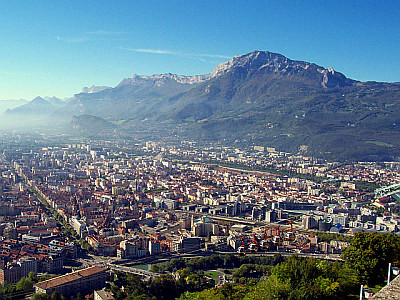
From Bastille Fort, the view over the city and the surrounding mountains is just magnificent !
To the west, we see the Vercors. We also see the ring building of the ESRF (European Synchrotron Radiation Facility) which has the most powerful synchrotron radiation source (kind of X-ray supermicroscope) in Europe.
To South and East, the massif of Oisans and Belledonne with its snowy peaks (the highest peak is 2977 m / 9767 feet high).
To the north the Chartreuse Mountains.
Perret tower
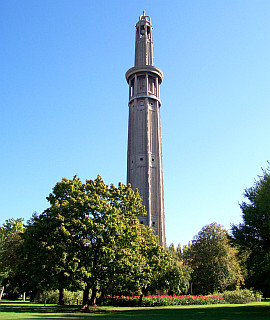
Perret tower owes its name to the architect Auguste Perret, who rebuilt the city of Le Havre after its destruction during the Second World War. It dates from the International Exhibition of 1925.
More visits
We can complete the visit with the three towers of Green Island (1964) and St. Andrew's collegial with its spiked bell tower built in tufa. About museums, there are particularly the Dauphinois Museum near fort Bastille and museum of Grenoble.
Nearby
-
Chartreuse mountains.
In the Chartreuse Mountains, you can go in Voiron where there are cellars of the famous monks' liquor : chartreuse. About the convent of Grande Chartreuse (La Correrie), we can not visit it but there is a museum which is open from april to november. I recommand seeing the movie "the great silence" from Philip Gröning (released in 2006) that gives an good insight of the lives of Carthusian monks.
-
Napoléon road.
The N85 from Grenoble to Sisteron is called Napoleon road because it was taken by the Emperor after his escape from Elba. The troops who had to arrest the Emperor met him at the place called "the meadow of the meeting" but instead of putting under arrest they joined him !
At Corps, one can see a church with spikes, typical of Grenoble region.
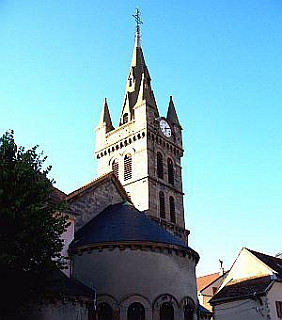
We can also take the road towards La Salette, a Catholic shrine.
-
South of Grenoble, the railway from La Mure has a traditional train.
